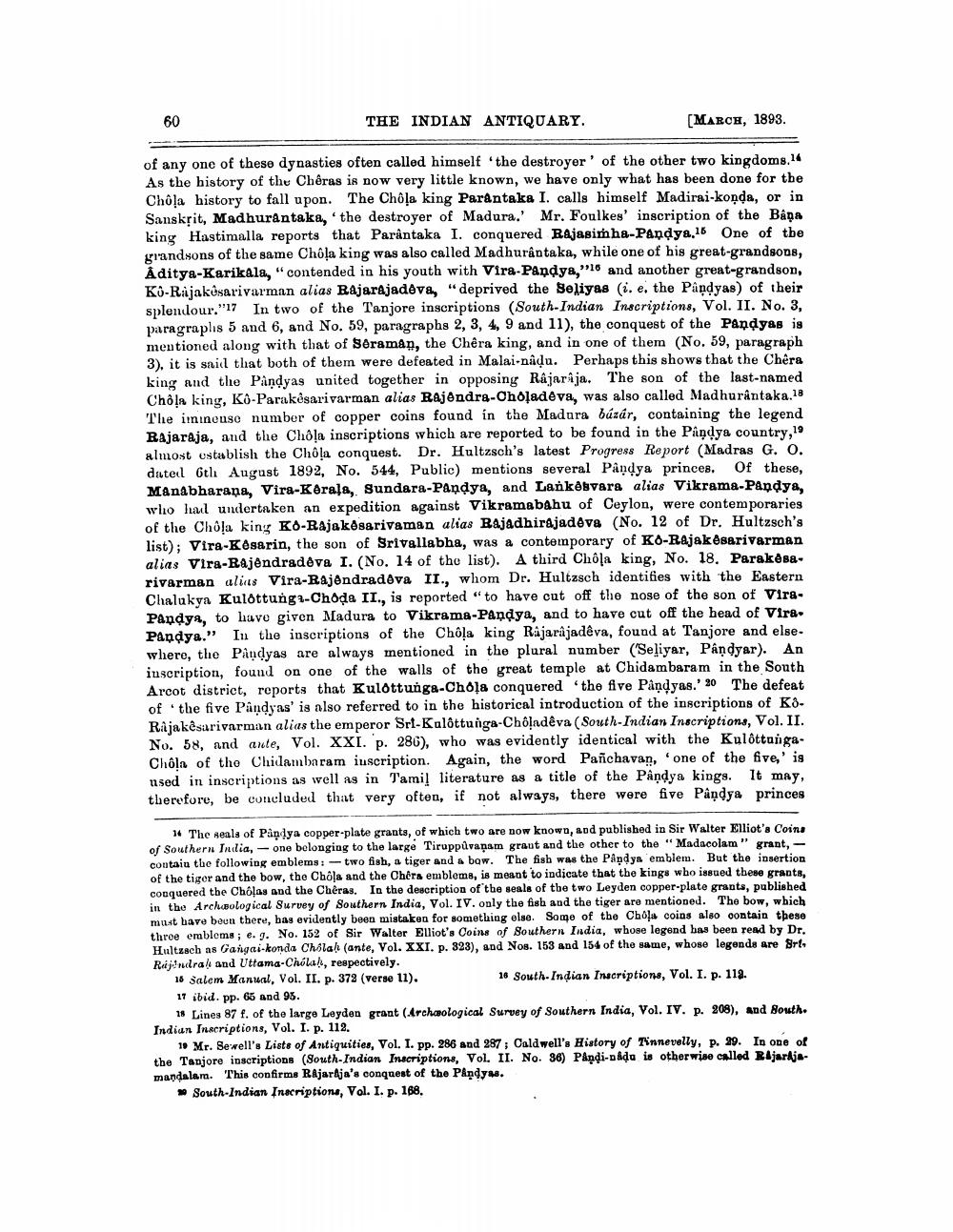________________
60
THE INDIAN ANTIQUARY.
[MARCH, 1893
of any one of these dynasties often called himself the destroyer of the other two kingdoms.14 As the history of the Chêras is now very little known, we have only what has been done for the Chola history to fall upon. The Chôļa king Parantaka I. calls himself Madirai-konda, or in Sanskrit, Madhurantaka, 'the destroyer of Madura.' Mr. Foulkes' inscription of the Bana king Hastimalla reports that Parântaka I. conquered BAjasimha-Pandya,16 One of the grandsons of the same Chôļa king was also called Madhurântaka, while one of his great-grandsons, Aditya-Karikala, "contended in his youth with Vira-Pandya,"l0 and another great-grandson, Ko-Rajakúsarivarman alias Rajarajadeva, “deprived the Seliyas (i. e, the Pandyas) of their splendour."17 In two of the Tanjore inscriptions (South Indian Inscriptions, Vol. II. No. 3, paragraphs 5 and 6, and No. 59, paragraphs 2, 3, 4, 9 and 11), the conquest of the Pandyas is mentioned along with that of Seraman, the Chêra king, and in one of them (No. 59, paragraph 3), it is said that both of them were defeated in Malai-nadu. Perhaps this shows that the Chera king and the Pandyas united together in opposing Rajaraja. The son of the last-named Chôļa king, Ko-Parakesarivarman alias Rajendra-Choladeva, was also called Madhurântaka.18 The imineuse number of copper coins found in the Madara bázár, containing the legend Rajaraja, and the Chola inscriptions which are reported to be found in the Paņdya country, 19 almost establish the Chola conquest. Dr. Hultzsch's latest Progress Report (Madras G. 0. datel 6th August 1892, No. 544, Public) mentions several Pandya princes. Of these, Manabharana, Vira-Kerala, Sundara-Pandya, and Lankòbvara alias Vikrama-Pandya, who hail undertaken an expedition against Vikramabahu of Ceylon, were contemporaries of the Chola king KO-Rajakosarivaman alias Rajadhirajadeva (No. 12 of Dr. Hultzsch's list); Vira-Kosarin, the son of Srivallabha, was a contemporary of Ko-Rajakesarivarman alias Vira-Rajendradeva I. (No. 14 of the list). A third Chôļa king, No. 18. Parakesarivarman alins Vira-Rajendradeva II., whom Dr. Hultzsch identifies with the Eastern Chalukya Kulottung 2-Choda II., is reported to have cut off the nose of the son of ViraPandya, to have given Madura to Vikrama-Pandya, and to have cut off the head of Vira. Pandya.” In the inscriptions of the Chola king Rajarajadêva, found at Tanjore and else. where, the Pandyas are always mentioned in the plural number ('Seliyar, Pandyar). An inscription, found on one of the walls of the great temple at Chidambaram in the South Arcot district, reports that Kulottunga-Chola conquered the five Påņdyas.' 20 The defeat of the five Pandyas' is also referred to in the historical introduction of the inscriptions of KoRajakesarivarman alias the emperor Srt-Kalôttunga-Chölndêva (South Indian Inscriptions, Vol. II. No. 58, and ante, Vol. XXI. p. 286), who was evidently identical with the KulôttungaChola of the Chidambaram iuscription. Again, the word Panchavan, one of the five,' is used in inscriptions as well as in Tamil literature as a title of the Pandya kings. It may, therefore, be concluded that very often, if not always, there were five Pandya princes
16 The seals of Paņdya copper-plate grants, of which two are now known, and published in Sir Walter Elliot's Coins of Southern India, - one belonging to the large Tiruppuvapam graut and the other to the "Madacolam” grant, - contain the following emblems: -two fish, a tiger and a bow. The fish was the Pâpdya emblem. But the insertion of the tiger and the bow, the Chola and the Chira emblems, is meant to indicate that the kings who issued these grants, conquered the Cholas and the Chéras. In the description of the seals of the two Leyden copper-plate grants, published in the Archeological Survey of Southern India, Vol. IV. only the fish and the tiger are mentioned. The bow, which must have boun there, bas evidently been mistaken for something else. Some of the Chola coins alec three emblems; e. 3. No. 152 of Sir Walter Elliot's Coins of Southern India, whose legend has been read by Dr. Hultzsch as Gangai-konda Chilak (ante, Vol. XXI. p. 323), and Nos. 153 and 154 of the same, whose legends are Srl Rajendral and Uttama-Chólal, respectively. 16 Salem Manual, Vol. II. p. 372 (verse 11).
18 South Indian Inscriptions, Vol. I. p. 112. 17 ibid. pp. 65 and 95.
18 Lines 87 f. of the large Leyden grant (Archaological Survey of Southern India, Vol. IV. p. 208), and South. Indian Inecriptions, Vol. I. p. 112.
10 Mr. Sewell's Lists of Antiquities, Vol. I. pp. 286 and 287; Caldwell's History of Tinnevelly, p. 29. In one of the Tanjore inscriptions (South Indian Inscriptions, Vol. II. No. 36) Påndi-nidu is otherwise called Eljardjamandalam. This confirms Rajaraja's conquest of the Pandyu.
South-Indian Inscription, Vol. I. p. 168.




